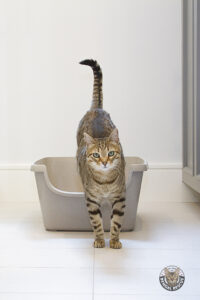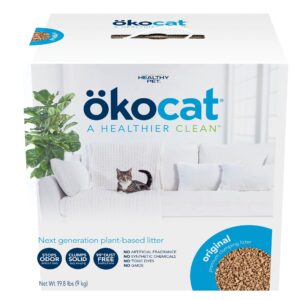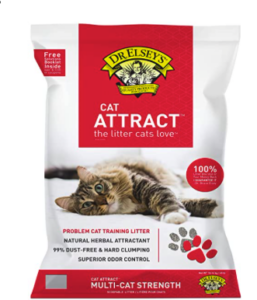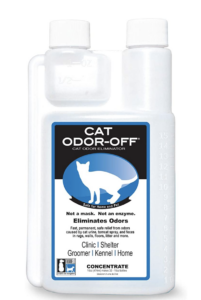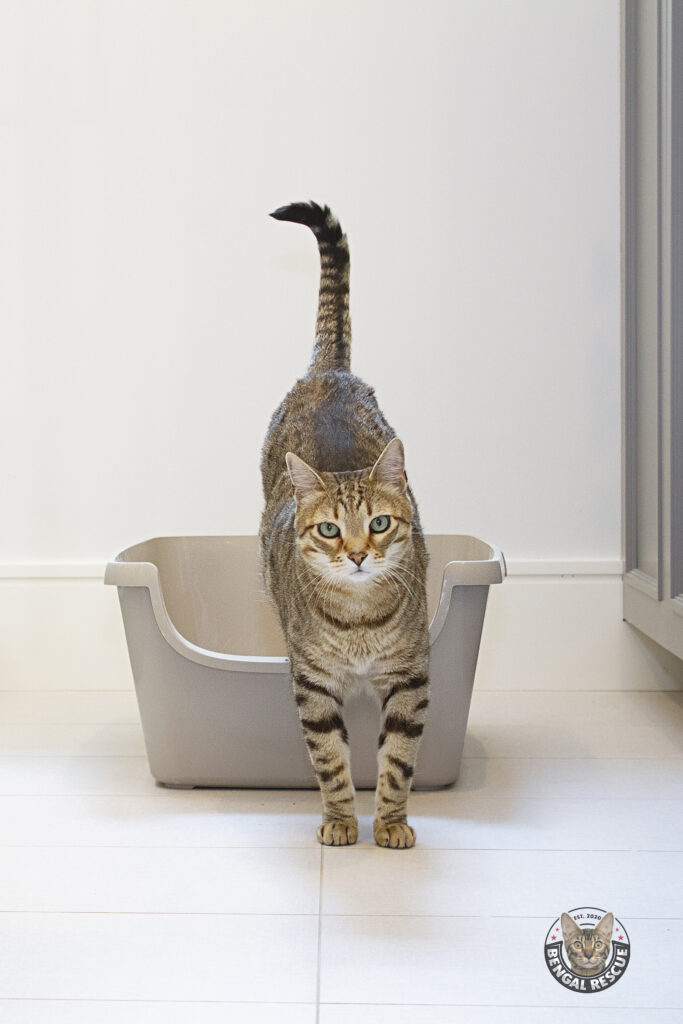
Litter Box Issues
The #1 reason why Bengal cats (including all cats) are surrendered to shelters and rescues is litter box avoidance.
In reality, it is usually improper litter box maintenance (on the part of the human) that creates litter box avoidance.
So many cat owners are not aware that litter box issues and / or litter box avoidance should ALWAYS result in an immediate Veterinary check, however most owners look for answers elsewhere.
We hope you’ll review the information here and do everything possible to resolve your cat’s litter box issues and keep them in your home.
Lack of Human Oversight
We constantly hear from clients: “My cat is urinating outside of the litter box because he’s mad at me.”
No. That’s not why.
While there are definitely cases where litter-box avoidance is a medical issue for cats, it is true that the majority of cases are the result of poor litter box setup and maintenance, which is always the responsibility of the owner.
Lack of human oversight often includes:
- Poor litter box maintenance. This is the #1 reason for litter box avoidance!! The golden rule is scoop AM and PM – and if you walk by the box and you see it isn’t pristine – scoop again. We literally had a client who said he scooped his boxes (two cats, one box) – once a week! We asked him if he also flushed his toilet, once a week? (His expression was priceless – he finally got it!).
- Covered litter boxes. If you don’t see it needs to be scooped – you won’t scoop it. Cat’s don’t want “privacy” – if you asked them they would tell you all they want is a CLEAN box at all times.
- Improper litter, such a corn or other substrates. Scented litter, etc.
- Improper changing of litter. Litter should be completely swapped out with new litter, no less than once per month.
- Inadequate cleaning. Litter boxes should be cleaned with hot water and Dawn soap every month, or more frequently if needed.
- Improper box, such as a box that is too small for the cat, covered litter box, litter box requiring them go into a cabinet or through a maze to get to it. No!
- Improper location. If a cat has to go on a treasure hunt to use their box every time – they will give up and find a more pleasing location.
- Inadequate number of boxes. You should always have one more box than the number of cats you have. Which means, if you have two cats – you should have three boxes.
- Resource guarding. Does your cat have easy access to the box, or do you have other pets preventing them from using the box, via intimidation tactics? Unless you have a Ring Camera pointed at the box – you’ll never know.
- Dry food only diet. We do not believe in dry food for cats. It has no moisture, it’s sprayed with a chemical that is a “flavor enticer” which has no nutritional value and makes the food addictive to cats (kind of like McDonald’s). Cats are obligate carnivores! They should only be fed a wet food or raw food diet. For more information on this topic check our Feeding Your Cat page.
- Poor maintenance of water bowl / no fountain. Cats need moisture because they have a very low thirst drive. Please check our Recommended Products page for more information.
- Clothing on the floor. Even if you weren’t exercising, all humans emit ammonia through their pores which remains behind on articles of clothing. The ammonia smell is an “attractant” for cats. If you put clothes / towels and other articles on the floor, you are inviting your cat to pee on that article. Pick up your clothes!
- Using the wrong cleaner for “accidents.” Most of the cleaning products you’ll find at Pet Stores simply do not work. We recommend Unique Pet Odor and Stain Eliminator (link to the product is below). It eliminates all odor, on carpets, floors, furniture, and other surfaces.
- Declawing your cat. Declawed cats are notorious for litter box avoidance! It is a brutal procedure and most have pain throughout their lives, and is the reason why Declawing is being banned nationwide. It is cruel and painful and is the reason why so many cats end up in shelters – litter box avoidance. Visit the PawProject for more information.
- Is your cat spayed / neutered? If not – well that is likely the issue.
For more information, please read the article “The Litter Box From Your Cat’s Point of View” by Dr. Lisa Pierson, DVM.
If you have done an honest assessment of your litter box maintenance and environment, and if you are adhering to the guidelines above, then it’s time to move to the next step.
Veterinary Intervention
All cats should be seen at least once annually, for a health check, however if your cat is urinating outside of the litter box – a Veterinary exam is ALWAYS called for.
Ask your Veterinarian to check for Urinary Tract Infection, crystals, stones, and other disorders that might explain underlying medical causes, for this problem.
Your Veterinarian will likely want to test your cat’s urine (usually with a clean urine pull taken by syringe) to assess whether or not your cat has a Urinary Tract Infection. If your cat tests positive for an infection – that is an ideal outcome. Your Veterinarian will likely prescribe antibiotics and hopefully that infection is cured and does not return.
However – if the Urinary Analysis comes out Negative – then it’s time for more testing and diagnostics. Your Veterinarian will likely indicate that the next step is to rule out kidney and bladder stones, as well as well as crystals in the urine, diabetes, and other conditions.
If your Veterinarian is unable to find any underlying causes that explain the inappropriate urination, it is possible that your cat has Feline Lower Urinary Track Disorder (FLUTD), formerly known as Feline Ideopathic Cystitis.
Explaining FLUTD
In the end, FLUTD is a baffling disorder where the cat doesn’t have an obvious underlying condition. They just constantly feel a burn when they have to pee, they think the litter box is what is hurting them, so they seek out other locations in the hopes that “this time it won’t hurt.” Stress and the “Bengal Brain” is a huge contributor to FLUTD. This is why so many cat owners become beyond frustrated, don’t find answers, don’t know what to do, and seek to re-home the cat. The cat can easily be cured.
FLUTD Treatment
Under the care and treatment of a Veterinarian, FLUTD is a CURABLE disorder. We have seen hundreds of cases that were beyond extreme, absolutely turn around with a miracle drug – Amitriptyline Transdermal.
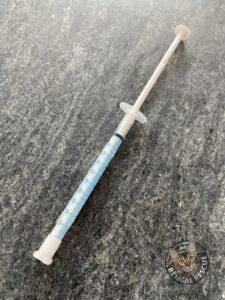
Amitryptyline coats the bladder so the discomfort is greatly reduced. This medication also has a magical property that “tones down” anxiety in a cat, which is one of the factors in Bengals that really fuels FLUTD (the anxiety).
A typical dose we’ve seen Veterinarians prescribe for a 10-12 pound cat is:
Amitriptyline HCL 10MG/0.1ML Transdermal
Apply 0.05 ML to the hairless area of the ear (inside the ear) daily.
This medication is a “controlled substance;” it can only be recommended and prescribed by a Licensed Veterinarian, and can only be compounded by a Compounding Pharmacy. This medication is not expensive – prices run around $10 per vial. A typical cat who receives the same prescription (above) would receive a 20 day supply, per syringe. The best part about this medication? You won’t have to pill your cat or give them liquid medication. We all know what a battle that is!
Be sure that you do NOT use a dispenser that “clicks” – if your cat hears the click he will run for the hills and you will have no chance of medicating him.
We highly recommend Meds4Vets – they ship all over the USA and their prescription is always accurate, and the dispenser is not a “click” dispenser.
FLUTD Success Story
One of our Board Members had a cat with a severe case of FLUTD. She sought answers, and our Veterinary Director Dr. Carl Prior had the answer – Amitriptyline. Her cat was on this medication for eight years – and did not have one incident of inappropriate urination for the rest of his life. She tested her cat annually for any possible negative impact – and his organs and blood work were not impacted by the medication – whatsoever.
Amitriptyline is a proven solution and we have seen hundreds of cats saved from being re-homed, who receive this medication. We have not seen similar results from Prozac, so if your Veterinarian initially suggests this medication, you might want to ask if they would consider trying Amitriptyline first. We have also heard of successful results using a combination of Amitriptyline and Gabapentin.
PLEASE CONSULT YOUR VET ABOUT THIS AND GIVE IT A TRY. Your beloved feline family member deserves that chance. IT WORKS.
Behavioral Intervention
A good behaviorist is one of the best tools you can have! You’ll want a Certified Cat Behavior Consultant (CCBC). Today’s behaviorists are the best detectives you can have. They will assess your case thoroughly, ask for your Vet records in advance, and give you a “get well plan.”
Most Behaviorists charge $300 or so. They will send you a very detailed Questionnaire. They will schedule a Video conference with you and your cat(s) and ask you to show them around your house, so that they can provide you with helpful solutions.
For more information see our page Behavioral Issues.
Litter Box Setup and Guidelines




Recommended Products
Below are our favorite recommended products, when it comes to Litter Box setup and maintenance.
Litter Box
We love this Frisco Litter box from Chewy.com. It has low entry on one side, and his high-sided for cats who stand up when they urinate (common Bengal trait).
As important as the litter box setup is – the MOST important thing is YOU! We ask you human to PLEASE scoop religiously. Every AM and PM. You should also scoop the times in-between; if you walk by and see that there is a “deposit” – scoop then too!
Most cats will hop right into the litter box and use it the moment you finish scooping. Why? It’s because they LOVE a clean box.
The golden rule is also +1 litter box more than the number of cats you have. So if you have two cats – you need three litter boxes.
With a little diligence and commitment on your part, you will be setting your cat up for success – and a lifetime of perfect litter box use.
Cat Litter
Clay litter has chemicals in it that help make it “clump” – the cat takes a bath, and now is ingesting those harmful chemicals. Please read this article to learn why clay litter is unadvisable Is Clay Litter Bad for Cat Health?
Because of the dangers of Clay Litter, we did our research – and we’re simply over the moon about Okocat Natural wood litter! It weighs 1/3 of what Clay-based litters weigh, it contains no chemicals at all, it clumps like a charm, keeps odor under control, and it’s easy on the budget!
We recommend both the “original” and the “super soft” versions. The Original version is closer to clay litter in texture, and the super soft version is a very fine substrate that is great for declawed cats.
Click on the photo and you can buy direct from Chewy.com
To learn more about okocat visit their website
Clay Litter
Some cats will not adjust to Okocat – it happens. Whenever there are litter box avoidance issues, we recommend Dr. Elsey’s Litter Attract. It does help stop litter box avoidance in it’s tracks!
Litter Genie
The Litter Genie makes scooping more efficient, but we do not recommended you keeping it near the litter box as kitty noses are sensitive!
Cleaner
If you are currently struggling with Litter Box issues, the most important thing you have to do to get things under control, is to invest in a GREAT enzyme cleaner. Pet Store shelves are overflowing with products that DO NOT WORK. Trust us, these are the only products that DO work.
Anti-Icky Poo
This is our #1 go to for cleaning up pet odors and stains. We’ve tested it on Carpet, Custom wood flooring, tile, walls, fabric, leather – you name it. Be sure to buy only the unscented.

Unique Pet Odor & Stain Eliminator
If the Anti-Icky Poo doesn’t do the trick – we move next to Unique. This product really works! It’s great on tile, on wood, on carpet, and on fabric. It is concentrated; a little goes a long way.
Thornell Cat Odor Off
Fantastic product! Cat Odor-Off is concentrated, so a little goes a long way.
Product Descriptions
Bengal Rescue attempts to be as accurate as possible. However, Bengal Rescue does not warrant that product descriptions or other content on the Site is accurate, complete, reliable, current or error-free. If a product recommended by Bengal Rescue is not as described, your sole remedy is to return the product to the manufacturer.
Bengal Rescue makes no claims or warranties with regards to any medical information on this site. It is not intended or recommended to be followed, in place of your Veterinary care.
© Bengal Rescue 2024
